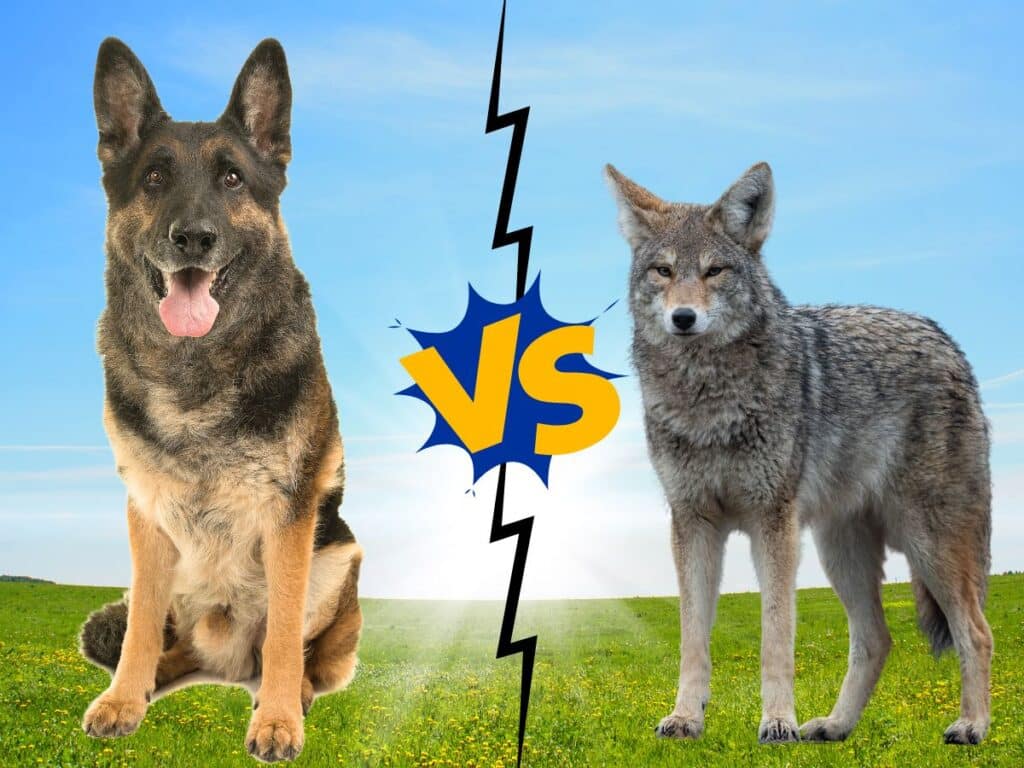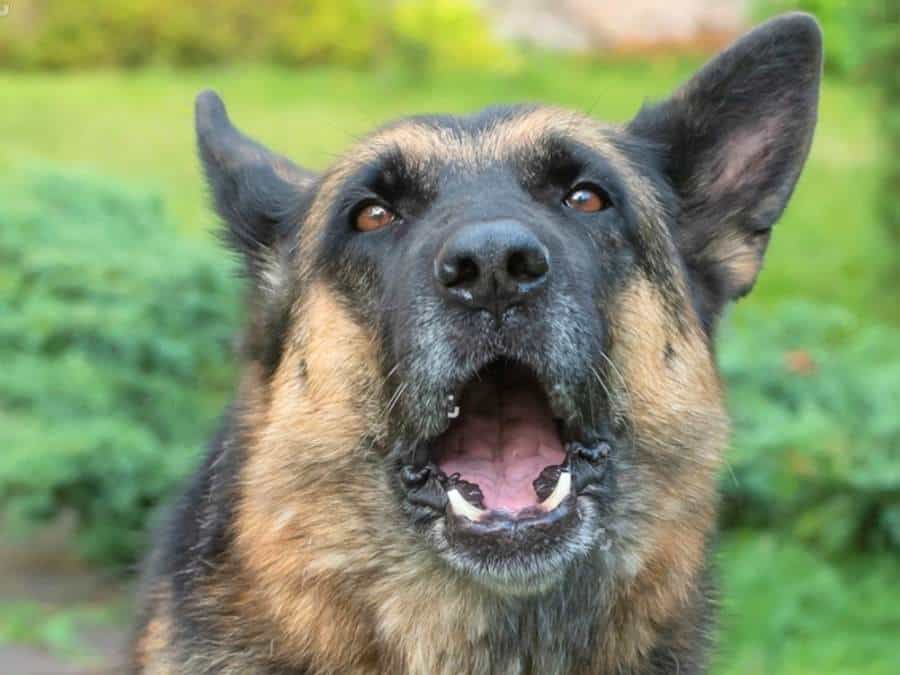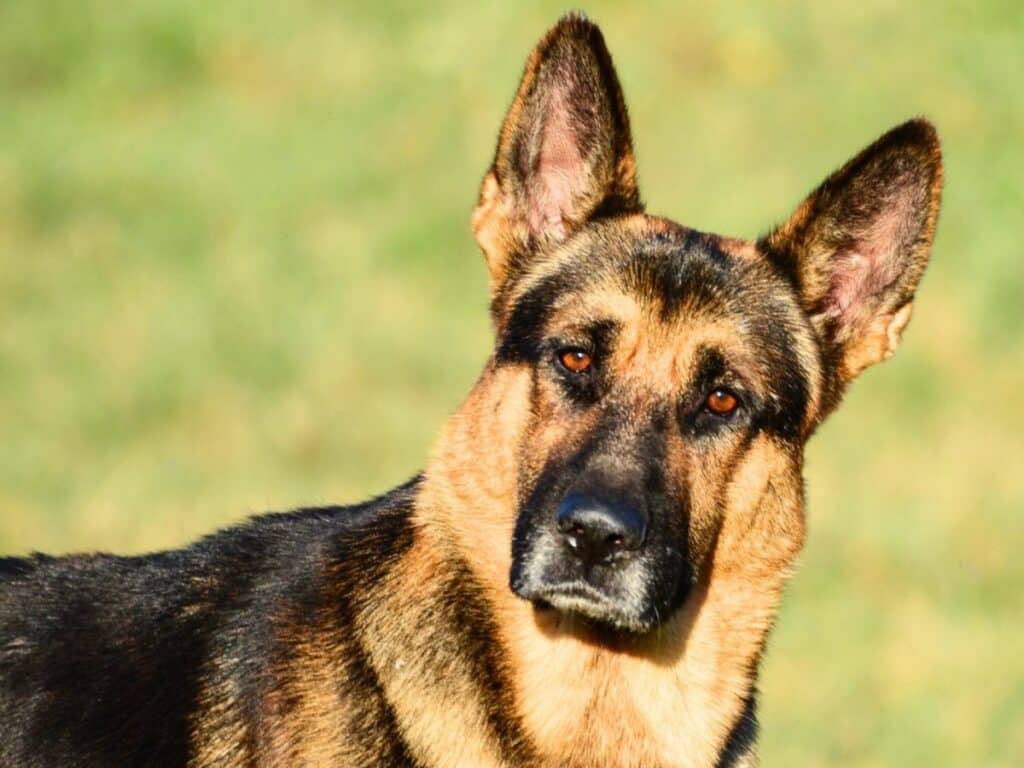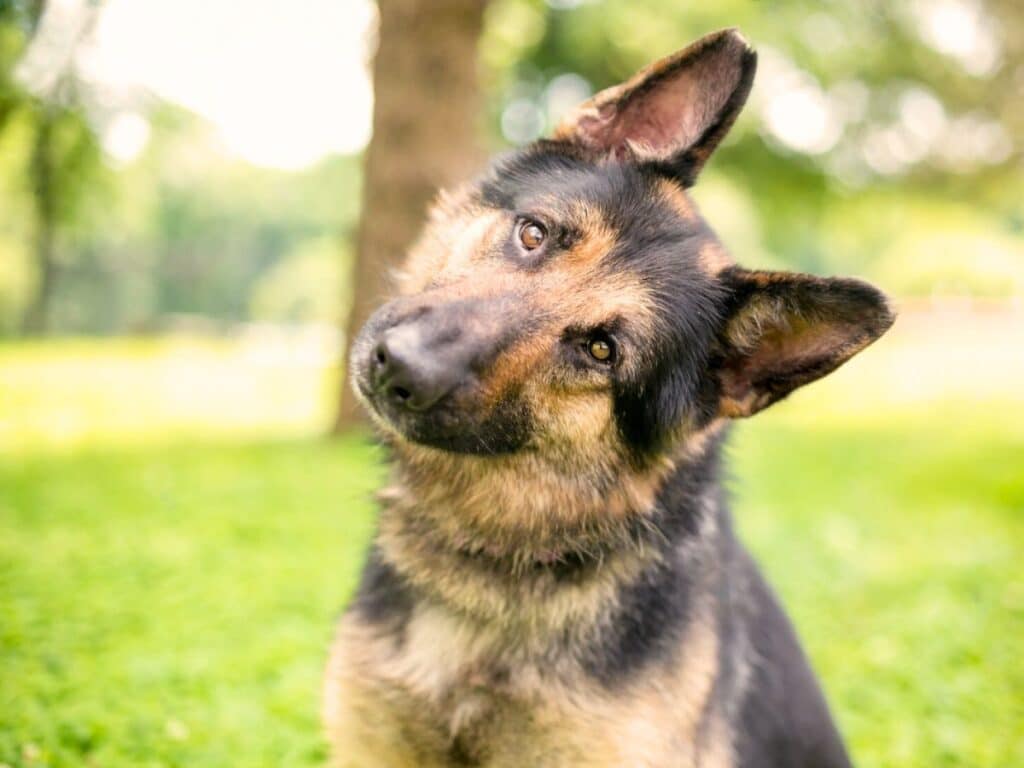Can a German Shepherd Kill a Coyote? The answer is yes, a German Shepherd has the potential to kill a coyote.
With a larger body build and a deadly bite force, an adult German Shepherd can kill a coyote by breaking its bones.
However, it is not recommended to encourage or train them to do so.
German Shepherds are known for their strength and agility, making them capable of taking down smaller predators. Coyotes are one such predator that can pose a threat to pets and livestock.
While it may seem like a good idea to have your German Shepherd act as protection against coyotes, there are risks involved.
It’s important to remember that encouraging this behavior can be dangerous for both your dog and the surrounding wildlife.
Let’s dive into how we can keep our furry friends safe while living in areas with coyotes.
Comparing Strengths and Weaknesses: German Shepherds vs Coyotes

German Shepherds are a Powerful Dog Breed
German Shepherds were originally bred for herding sheep but have since become widely used as police dogs, guard dogs, and family pets.
One of the reasons why German Shepherds are so popular is because they are muscular, large dogs with powerful jaws and a strong bite force that can inflict serious damage to a coyote.
A full-grown male German Shepherd can weigh up to 90 pounds and stand up to 26 inches tall at the shoulder.
Their muscular build and strong jaws can generate a bite force of 238 psi which can be lethal for smaller animals like coyotes.
However, it’s important to note that not all German Shepherds are created equal. Factors such as size, age, and health can impact their physical abilities.
Coyotes Rely on Agility and Speed
Coyotes are known for their agility and speed, which they use to hunt prey and evade predators.
They have sharp teeth and claws that allow them to capture their prey quickly.
Coyotes typically weigh between 20-50 pounds and stand about two feet tall at the shoulder.
While coyotes may not be as physically strong as a German Shepherd, they make up for it with their hunting skills.
Coyotes are incredibly agile animals that can easily outrun most domesticated dogs. They also have excellent hearing and sense of smell which allows them to detect danger from far away.
Can a German Shepherd Kill a Coyote? It Depends.
In a confrontation between a German Shepherd and a coyote, the outcome would depend on various factors such as size, age, health, experience, and training level of both animals involved in the encounter.
If an adult healthy German Shepherd confronts an adult healthy coyote in an open field or forested area without any other external factors (e.g., human intervention, environmental factors), the German Shepherd would have a significant advantage due to its size and strength.
However, if the coyote is experienced in hunting and evading predators, it could still potentially outsmart and outrun the German Shepherd.
It’s important to note that while German Shepherds are powerful dogs, they are not invincible.
A pack of coyotes or an injured or sick coyote could pose a serious threat to even the strongest of German Shepherds.
If a German Shepherd is not properly trained or socialized with other animals, it may be more likely to engage in aggressive behavior towards other animals.
Weight and Size: How Does a German Shepherd Compare to a Coyote?

One of the most significant factors that determine the outcome of a physical confrontation between two animals is their size and weight.
As we already discussed, German Shepherds are generally larger than coyotes, with an average weight of 50-90 pounds compared to a coyote’s average weight of 20-50 pounds.
In this case, German Shepherds have a clear advantage over coyotes due to their larger size and heavier build.
German Shepherds are known for their muscular and sturdy body build, which allows them to overpower smaller animals like coyotes.
Their large size and heavy weight make them formidable opponents in any fight.
On the other hand, coyotes are much smaller in comparison, with an average weight ranging from 20-50 pounds.
While they may be agile and fast on their feet, they lack the physical strength required to take down larger animals like German Shepherds.
In most cases, when faced with danger or threatened by another animal, both German Shepherds and coyotes will try to avoid confrontation.
However, if push comes to shove, the sheer size difference between these two animals could be enough for the German Shepherd to come out on top.
RELATED:
Coyote Habits: When and Where Do They Appear?

Coyotes are nocturnal animals
Coyotes are primarily nocturnal animals, which means they are more active during the night. However, it’s not uncommon to see them during the day as well.
They have adapted to living in suburban areas and can be found in open fields, forests, and even residential neighborhoods.
During the summer months, coyotes tend to be less active during the day due to the heat.
On the other hand, during winter months when food is scarce, they may be seen more frequently during daylight hours.
Coyotes can be found in various habitats
Coyotes belong to the Canidae family. The Canidae family, also known as canids, includes a wide range of mammals such as wolves, foxes, jackals, and domestic dogs.
Coyotes can be found in a variety of habitats such as grasslands, deserts, forests, and urban areas.
They prefer areas with plenty of cover for hiding and hunting prey.
In suburban areas where food sources are abundant (such as bird feeders or unsecured garbage cans), coyotes may become more comfortable approaching human settlements.
This is why it’s important to take necessary precautions such as keeping your pets indoors at night and securing any potential food sources.
Coyotes travel in packs but sometimes appear alone
Coyotes usually travel in packs consisting of family members. However, sometimes a lone wild coyote or “dad coyote” can be seen searching for food.
Lone coyotes are often male adults that have been driven away from their pack by younger males.
These lone individuals may pose a greater threat since they’re more desperate for food and could potentially attack pets or livestock.
Coyotes are opportunistic predators
Coyotes are opportunistic predators that will prey on small animals such as rabbits, rodents, and even domestic pets if given the opportunity.
They also scavenge on carrion (dead animals) when available.
It’s important to keep an eye out for coyotes when walking your dog or letting them outside at night.
Coyotes can be attracted to the sounds of small animals or even the scent of pet food left outside.
Protecting Against Coyote Attacks

Coyote Attacks on Humans and Domestic Animals
Coyote attacks on humans and domestic animals are a real threat, especially in areas where coyotes are prevalent.
These wild animals can cause serious harm to pets such as cats and rodents, as well as to livestock. In some cases, coyote attacks have even been fatal to humans.
To protect against coyote attacks, it’s important to understand their behavior.
Coyotes are opportunistic predators that will prey on any animal that they deem easy targets.
They often hunt at night or early morning when it’s still dark outside.
Coyotes can be attracted to neighborhoods by the presence of food sources such as garbage cans or pet food left outside.
One way to reduce the likelihood of coyote attacks is by removing potential food sources from your property.
This includes securing garbage cans with tight-fitting lids and keeping pet food indoors or bringing it inside after feeding time.
It’s important to keep small pets such as cats indoors at night or on a leash while outside.
Animal Control Measures
Animal control measures such as hunting and trapping can help reduce the number of wild animals in urban areas, which can decrease the likelihood of coyote attacks.
However, these methods should only be used by trained professionals who follow all local laws and regulations.
Hunting is one way to control the population of wild animals such as coyotes. It’s important for hunters to use safe practices and follow all hunting laws in their area.
Trapping is another method that can be used but requires specific knowledge and skills to do so safely.
In some cases, relocation may also be an option for dealing with problem wildlife like coyotes.
However, this should only be done by licensed professionals who have experience handling wild animals.
Keeping Pets Safe
Keeping pets safe from becoming prey to coyotes or other wild animals requires taking proactive measures.
One of the most effective ways to protect pets is by keeping them indoors or on a leash while outside.
This can prevent them from wandering too far and becoming vulnerable to attacks.
It’s important to supervise pets while they are outside and make sure they are not left unattended for long periods of time.
Installing motion-activated lights around your property can also help deter coyotes and other predators from coming near.
Understanding Coyote Behavior
It’s important to remember that coyotes have a natural fear of humans, but they may become more aggressive if they feel threatened or if they have become accustomed to being around people.
If you encounter a coyote, it’s best to keep your distance and avoid approaching it. Make loud noises or throw objects in its direction if it gets too close.
If you live in an area where coyotes are prevalent, it’s important to take steps to protect yourself, your family, and your pets.
By removing potential food sources from your property, using animal control measures when necessary, keeping pets on a leash or indoors at night, and understanding coyote behavior, you can reduce the likelihood of attacks and increase your chances of survival in the event of an attack.
How to Keep Coyotes Out of Your Property

Installing a Chain Link Fence
If you’re looking for the most effective way to keep coyotes out of your property, installing a fence around your yard is the way to go.
A chain link fence with a height of at least 6 feet can prevent coyotes from jumping over it.
This type of fence is also durable and long-lasting, making it an excellent investment for homeowners.
However, coyotes are excellent climbers, so make sure to install a fence that extends at least 6 inches below ground level to prevent them from digging underneath it.
It’s important for owners to regularly inspect their fences for any damages or gaps that coyotes can exploit.
Avoid Attracting Coyotes
Coyotes are attracted to food sources, so avoid leaving pet food or garbage outside where they can easily access it.
If possible, store garbage cans in a secure location such as a shed or garage until trash day. Similarly, if you have outdoor pets, don’t leave their food bowls outside overnight.
Living Near Natural Areas
If you live near a park or natural area, be aware that coyotes may still enter your property despite having a fence.
In these cases, it’s important to take extra precautions such as keeping your pets indoors during dawn and dusk when coyote activity is highest.
Consider using motion lights and sprinklers near the perimeter of your property as this can deter coyotes from entering.
You may also want to invest in coyote deterrents such as noise-making devices or predator urine which can help keep them away.
Other Types of Fences
While chain link fences are the most effective option for keeping out coyotes due to their durability and height requirements, other types of fences may also work depending on your specific situation.
For example, solid wood fences provide privacy but may not be high enough to prevent coyotes from jumping over.
Electric fences can also be effective but require a power source, making them less practical for some homeowners.
Dealing with Coyotes: What to Do If You Encounter One

Wild coyotes can be dangerous if provoked or threatened
Coyotes are wild animals that can be found in many parts of North America, including urban areas.
While they are generally shy and avoid human contact, they can become aggressive if they feel threatened or cornered.
It is important to know what to do if you encounter a coyote while walking in your neighborhood or out in the wilderness.
Make yourself look bigger by raising your arms and standing on your tiptoes
If you spot a coyote while out on a walk, the first thing you should do is try to make yourself look bigger.
This will help deter the coyote from approaching you. Raise your arms above your head and stand on your tiptoes. This will make you appear larger and more intimidating to the coyote.
Make loud noises, such as clapping or shouting, to scare the coyote away
If making yourself look bigger does not deter the coyote, try making loud noises.
Clap your hands or shout loudly at the animal. This will often startle it and cause it to run away.
If you have a whistle or air horn with you, use it to create a loud noise that will scare off the animal.
Do not turn your back on the coyote or run away
It is important not to turn your back on a coyote or run away from it as this may trigger its predatory instincts.
Instead, maintain eye contact with the animal and slowly back away from it while continuing to make yourself look big and making loud noises.
Throw rocks or other objects in its direction if it continues to approach
If despite all efforts, the coyote continues to approach you, throw rocks or other objects in its direction.
This will help deter it from attacking and give you time to get away safely.
What should I do if I see a coyote near my home or on my property?
If you spot a coyote near your home or on your property, it is important to take steps to deter it from coming closer.
Make sure all trash cans are securely closed, remove any pet food left outside, and keep pets indoors at night.
If you have a garden, consider putting up a fence to keep coyotes out. You can also use motion-activated lights and sprinklers to scare off any animals that come into your yard.
Real Stories of German Shepherds vs Coyotes
German Shepherds are well-known for their protective instincts, making them excellent guard dogs.
They are intelligent, loyal, and brave, which makes them perfect for protecting their owners from any potential threats.
One of the most common predators that threaten pets in suburban areas is coyotes. However, many real-life stories show that German Shepherds can successfully fend off coyotes.
Janet Kessler’s Experience with a GSD & a Coyote
Janet Kessler, a renowned wildlife photographer with more than two decades of experience studying coyotes, had encountered numerous interactions between these wild creatures and domestic pets throughout her career.
One particular incident stood out in her memory.
It happened in a beautiful San Francisco park where Janet was observing the local wildlife.
Suddenly, she noticed a small German Shepherd, weighing around 70 pounds, energetically pursuing a small coyote that weighed only about 30 pounds.

The dog was swift and persistent in its chase, but the coyote proved to be even faster.
Despite the owner’s frantic calls, the dog paid no attention and continued its pursuit.
Eventually, the coyote abruptly stopped and stood motionless, leaving the dog confused about its next move. Both animals locked eyes, silently evaluating each other.
Coyotes possess the ability to visually assess a dog’s character and intentions.
With just one glance at the German Shepherd, the coyote deduced that this dog was all show and no substance.
Nevertheless, the coyote disliked being chased, and the situation had now taken an unexpected turn.
Realizing that the coyote meant serious business, the dog swiftly changed its course and began running away with great speed, tail tucked firmly between its legs.

Seeking refuge and safety, the dog sprinted back to its owner’s side.
As the dog reached its owner, the coyote halted its pursuit and turned in the opposite direction, no longer interested in confrontation.
How to Handle the Aftermath of a Coyote Attack
The Outcome Can Be Severe
Coyote attacks can be severe, resulting in injuries or even death for pets and humans.
It’s important to take every precaution necessary when dealing with these animals.
While they may seem harmless at first glance, coyotes are wild animals that should be treated with caution.
Injuries sustained during a coyote attack can range from minor cuts and scrapes to more severe wounds that require medical attention.
In some cases, end-stage otitis, a severe ear infection, is a potential risk for dogs that have been attacked by coyotes.
Proper Cleanup Is Essential
Proper cleanup after a coyote attack involves disposing of any waste or debris left behind and seeking medical attention for any injuries sustained during the attack.
It’s essential to clean up any blood or other bodily fluids left behind as these can attract other predators.
If your pet has been attacked by a coyote, it’s important to seek veterinary care immediately. Even minor wounds can become infected if not treated promptly.
End-stage otitis is one potential complication that requires immediate treatment by a veterinarian.
In addition to seeking medical attention for yourself or your pet, it’s also important to report the incident to local authorities.
This helps them track patterns of behavior among local wildlife populations and take appropriate steps to prevent future incidents.
Factors That Determine Whether a German Shepherd Can Kill a Coyote

Understanding the Odds of a German Shepherd Winning in a Fight Against a Coyote
Coyotes are known to be fierce and skilled hunters, but they are not invincible. A German Shepherd, on the other hand, is one of the most powerful dog breeds in the world.There are several factors that come into play.
The first factor is age. Younger dogs tend to be more energetic and agile than older dogs. A younger
German Shepherd may have an easier time taking down a coyote due to its increased agility and energy levels.
Another factor that plays into this equation is size.
Generally speaking, larger dogs have an advantage over smaller ones. However, there are some cases where smaller dogs can outmaneuver their larger counterparts.
Finally, health is another important factor.
If your German Shepherd is healthy and well-fed, it will have more energy and strength than if it were sickly or malnourished.
Why German Shepherds Have Higher Chances of Killing Coyotes
German Shepherds are bred for their strength and agility, which makes them one of the breeds with higher chances of killing coyotes.
They were originally bred as working dogs for farmers in Germany who needed help herding sheep and protecting them from predators.
Their physical attributes make them perfect for this type of work – they have strong jaws and sharp teeth that can easily take down prey, as well as powerful legs that allow them to run at high speeds.
Their intelligence makes them great problem-solvers. They are able to think on their feet and adapt quickly to changing circumstances.
How Coyotes Can Outsmart Even the Most Powerful Dogs
Despite all these advantages that German shepherds have, coyotes are skilled hunters that can easily outsmart a German Shepherd in certain situations.
Coyotes are known for their cunning and ability to adapt to different environments.
For example, coyotes may lure dogs into ambushes by pretending to be injured or weak.
They may also use their superior speed and agility to outrun a dog or evade its attacks.
Furthermore, coyotes often hunt in packs, which gives them an advantage over solitary dogs like German Shepherds.
A pack of coyotes can easily overwhelm a single dog, even one as powerful as a German Shepherd.
How Training and Supervision Can Increase the Likelihood of Success
While there is no guarantee that a German Shepherd can kill a coyote, proper training and supervision can increase the likelihood of success.
This means making sure your dog is well-fed and healthy, as well as providing it with regular exercise and playtime.
Training your dog to obey commands is also important.
If your dog knows how to come when called or stay on command, you will have more control over it in potentially dangerous situations.
Finally, supervising your dog when it is outside is crucial. Coyotes are most active at dawn and dusk, so make sure you keep an eye on your dog during these times.
If you live in an area with high coyote activity, consider keeping your dog indoors during these times or building a secure fence around your property.
Conclusion
After comparing the strengths and weaknesses of German Shepherds and coyotes, it’s clear that a German Shepherd has the potential to kill a coyote.
However, there are several factors to consider when determining the likelihood of such an encounter.
Weight and strength play a significant role in this scenario, as well as the habits of coyotes and their diet and habitat. Protecting against coyotes is crucial for both humans and other animals, particularly if you live in an area where they frequently appear.
Ultimately, while it’s possible for a German Shepherd to kill a coyote, it’s important to take preventative measures to avoid these encounters altogether.
Frequently Asked Questions (FAQs)
1. Can I train my German Shepherd to protect against coyotes?
Yes! With proper training and socialization, your German Shepherd can be trained to protect against predators like coyotes. It’s best to work with professional trainers who specialize in this type of training.
2. Are there any products that can help keep my yard safe from coyotes?
Yes! There are several products on the market designed specifically for keeping predators like coyotes out of your yard. These include motion-activated sprinklers, ultrasonic animal repellents, and physical barriers like fences or netting.
3. What should I do if I see a coyote near my home?
It’s important not to approach or attempt to feed the animal. Instead, make loud noises or use deterrents like air horns or pepper spray to scare the coyote away. If the coyote appears sick or aggressive, contact your local animal control agency.
4. Can coyotes attack humans?
While rare, coyote attacks on humans have been reported. It’s important to take preventative measures like keeping a safe distance from the animals and avoiding feeding them.
5. How do I know if my German Shepherd is capable of protecting against predators like coyotes?
It’s best to consult with a professional trainer who can assess your dog’s temperament and abilities. Age can play a factor in how well a German Shepherd can protect against predators like coyotes.




